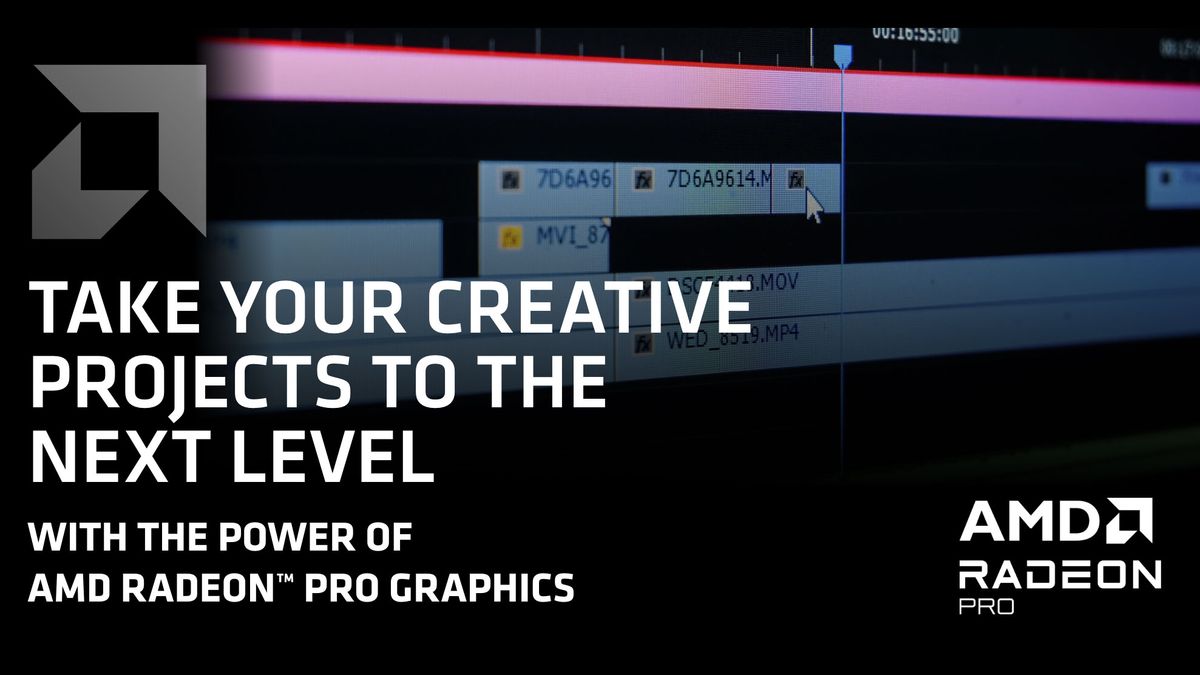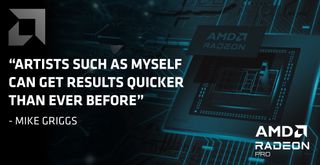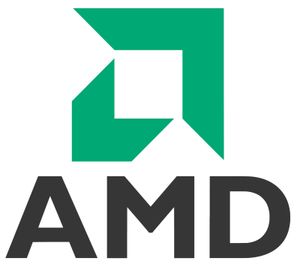AMD Radeon GPUs turbocharge new AI tools in CG software – here’s how

Artists and designers understand the frustration that can be caused by time-intensive tasks. They interrupt the creative flow and can often cause delays. But new technology has come to the rescue.
Backed by AMD Radeon GPUs, AI tools are poised to transform the way that artists work. From video production to visual effects, from rendering to retouching, new artificial intelligence (AI) and machine learning (ML) features in graphics applications speed up routine tasks and take the drudgery out of repetitive ones, leaving artists free to focus on their creative goals.
Read about four ways these GPUs will enhance your creativity, then learn more with AMD.
01. New AI tools speed up day-to-day workflow
One artist tapping into the potential of AI through AMD hardware is Mike Griggs, a Digital Content Creation Consultant whose clients include international businesses like the BBC and JCDecaux.
“A powerful graphics workstation helps my productivity [by] accelerating the AI features of my content creation tools,” he says. “I've been using workstations with AMD Radeon™ PRO GPUs to enable these new experiences.”
Mike says that he sees the largest day-to-day improvements in post-production, thanks to the new AI features in applications like DaVinci Resolve, Blackmagic Design's video editing, colour grading and VFX software. Neural Engine, the machine learning system available in the Studio edition of the software, speeds up a range of routine tasks, including audio transcription, video stabilisation and object tracking, and can automatically generate masks and depth maps from source footage.
The latest stable release, DaVinci Resolve Studio 18.6, helps Neural Engine harness the power of AMD GPUs. In tests, AI-based mask generation and tracking tool Magic Mask now runs over 4x faster on a current high end AMD Radeon RX 7900 XTX GPU than in the previous release.1
“[Magic Mask] enables me to create custom masks for my 3D work without needing to go back to my 3D software, says Mike. “Artists such as myself can get results quicker than ever before”.
02. AMD GPUs power AI processing
AMD GPUs can accelerate these new tools thanks to their specialist AI hardware. The RDNA™ 3 GPU architecture, used in AMD Radeon™ PRO W7000 Series and AMD Radeon™ RX 7000 Series GPUs, features two dedicated AI accelerators per compute unit.
On top of that, the graphics memory capacity of workstation cards from the Radeon PRO W7000 Series makes it possible to process large data sets. With 48GB of fast GDDR6 memory, the Radeon™ PRO W7900 GPU can handle even large production assets without the performance hit from going out of core.
And having a GPU in your workstation capable of accelerating AI tools helps to keep workflows local. Not needing to process jobs online avoids the need to upload commercially sensitive data to the cloud, reduces demands on network bandwidth, and provides more control over deadline-critical tasks.

03. Compatible with key graphics software
Nor is DaVinci Resolve the only CG application that can harness AMD GPUs to accelerate AI processing. Boris FX's Continuum plugins for VFX and motion graphics work include a range of AMD-compatible ML tools, for tasks ranging from blurring out faces to retiming video.
Twixtor, RE:Vision Effects' video retiming plugin for software like After Effects and Premiere Pro, also features a new machine learning algorithm – again, fully accelerated by AMD GPUs. Topaz Labs' Gigapixel AI and Video AI upscale still images and video, while 3D software Blender uses AI to remove noise from renders generated by its Cycles renderer.
04. AMD GPUs accelerate creativity
With their dedicated AI accelerators, the GPUs of the AMD Radeon™ PRO W7000 Series and AMD Radeon™ RX 7000 Series can speed up these everyday workflows, while the additional GPU memory available in workstation cards makes it possible to process even complex production scenes on a local workstation, without the need to upload sensitive data to the cloud.
For artists like Mike Griggs, the speed boosts reduce interruptions in creative workflows, and make it possible to turn around jobs quicker.
“I'm glad that my AMD graphics workstation is already well-placed to make the most of these new opportunities, while providing real-world benefits to my business and clients today,” he says.
Find out more about how AMD Radeon™ graphics can enhance your creative output.
Footnotes
1 Testing conducted by AMD as of September 19, 2023, on a test system configured with a Ryzen 9 5900X CPU, 32GB DDR4, Radeon RX 7900 XTX GPU, and Windows 11 Pro, with AMD Software: Adrenalin Edition 23.9.1, using the application Black Magic DaVinci Resolve 18.6 vs. Black Magic DaVinci Resolve 18.5. Data was gathered on the HD to 8K UHD 4x (Playback FPS @ 1080p Timeline), Speedwarp 10% (Playback FPS @ 1080p timeline), and Magic Mask Tracking – Better (FPS). Performance may vary. System manufacturers may vary configurations, yielding different results. RX-997
All performance and/or cost savings claims are provided by Mike Griggs of creativebloke and have not been independently verified by AMD. Performance and cost benefits are impacted by a variety of variables. Results herein are specific to Mike Griggs and may not be typical. GD-181.
David Diederichs is Product Marketing Manager for AMD. His postings are his own opinions and may not represent AMD’s positions, strategies or opinions. Links to third party sites are provided for convenience and unless explicitly stated, AMD is not responsible for the contents of such linked sites and no endorsement is implied. GD-5
RE: Vision Effects images courtesy of Clark Dunbar, Mammoth HD, Continuum images courtesy of Boris FX.

Thank you for reading 5 articles this month* Join now for unlimited access
Enjoy your first month for just £1 / $1 / €1
*Read 5 free articles per month without a subscription

Join now for unlimited access
Try first month for just £1 / $1 / €1
Get the Creative Bloq Newsletter
Daily design news, reviews, how-tos and more, as picked by the editors.
The Creative Bloq team is made up of a group of design fans, and has changed and evolved since Creative Bloq began back in 2012. The current website team consists of eight full-time members of staff: Editor Georgia Coggan, Deputy Editor Rosie Hilder, Ecommerce Editor Beren Neale, Senior News Editor Daniel Piper, Editor, Digital Art and 3D Ian Dean, Tech Reviews Editor Erlingur Einarsson, Ecommerce Writer Beth Nicholls and Staff Writer Natalie Fear, as well as a roster of freelancers from around the world. The ImagineFX magazine team also pitch in, ensuring that content from leading digital art publication ImagineFX is represented on Creative Bloq.


